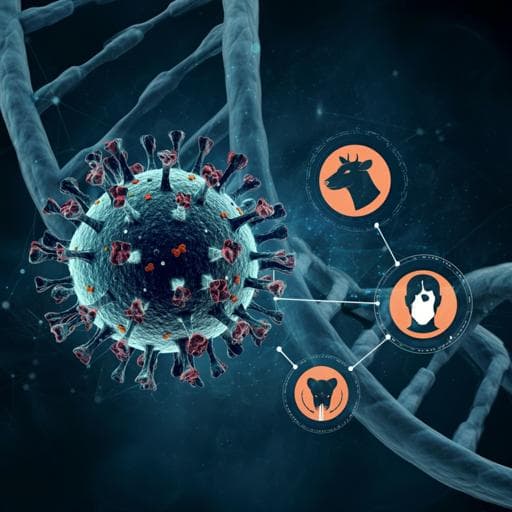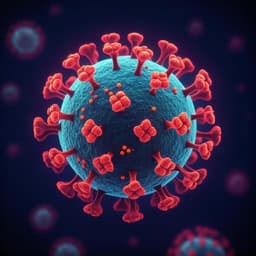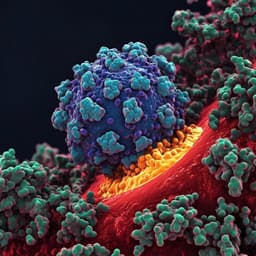
Medicine and Health
Transmission of SARS-CoV-2 from humans to animals and potential host adaptation
C. C. S. Tan, S. D. Lam, et al.
Explore how SARS-CoV-2, the virus behind the COVID-19 pandemic, adapts in various mammals! This study by Cedric C. S. Tan, Su Datt Lam, Damien Richard, and colleagues delves into unique mutations in mink and white-tailed deer, revealing insights into the virus's ability to jump hosts with minimal adaptations. Discover the implications of these findings on human transmission dynamics.
~3 min • Beginner • English
Introduction
The study investigates whether and to what extent SARS-CoV-2 requires host-adaptive mutations to spill over into and transmit within non-human mammals, and how circulation in animal hosts affects its evolutionary dynamics. SARS-CoV-2 likely emerged via zoonotic spillover from bat-associated sarbecoviruses and shows broad mammalian host range largely due to conserved ACE2 receptors. After widespread human transmission, numerous human-to-animal spillovers were observed, notably in farmed mink and wild white-tailed deer, with evidence of efficient animal-to-animal transmission and occasional spillback to humans. The research aims to characterise host-specific adaptation by comparing animal-associated SARS-CoV-2 genomes to matched human datasets, examining mutational biases, genomic composition, substitution rates, and recurrence of specific mutations indicative of adaptation in mink and deer.
Literature Review
Prior work indicates that SARS-CoV-2 was likely pre-adapted for human infection, with conserved ACE2 usage across mammals and early analyses failing to identify strong human-adaptive mutations. Subsequent emergence of more transmissible human Variants of Concern (Alpha, Delta, Omicron) suggests ongoing adaptation in humans. Multiple animal infections have been documented across pets, captive big cats, farmed mink, and wild white-tailed deer; mink farms experienced rapid spread and spillback, including the Danish 'cluster 5' lineage with Spike changes and partial immune escape. Reports in 2021 documented extensive spillover into deer with high prevalence and seropositivity. Previous structural and experimental studies showed certain Spike RBD mutations (e.g., Y453F, F486L, N501T) can improve entry via mustelid ACE2, but their fitness effects in humans are limited or negative. These contexts motivate a systematic genomic comparison of animal versus human viral populations to detect host adaptation.
Methodology
- Data acquisition: Retrieved all animal-associated SARS-CoV-2 genomes present in the 17 March 2022 GISAID Audacity (UShER) tree; extracted aligned genomes (masked MSA, 26 March 2022). Human isolates were subsampled into two backgrounds: (1) background 1 matched by country, PANGO lineage, and sampling dates (±1 month), with lineage-balanced subsampling; (2) background 2 of 10 human isolates per lineage per country irrespective of date.
- Phylogenetics: Built maximum-likelihood trees (IQ-TREE, GTR+I) and visualised via Dendroscope/ggtree; also used subtrees from Audacity to reduce computation. Curated monophyletic animal clusters (supported by ≥90% SH-aLRT and ≥93% UFBoot) by inspecting global and host-specific trees to infer independent spillover clusters.
- Recurring mutations: Screened mink-only (n=928) and deer-only (n=95) phylogenies with HomoplasyFinder for homoplastic sites (consistency index <0.5), counted independent emergences. Computed allele frequencies in animal sets versus human background 1. Candidate host-adaptive mutations satisfied: (A) ≥2-fold higher frequency in animals than matched humans; (B) animal allele frequency >0.1; or (C) ≥3 independent emergences in animal phylogeny. Further prioritised those not inherited from parent human lineage (D) and present in ≥3 independent animal clusters (E).
- Mutational biases and genomic composition: Quantified nucleotide transition spectra and dinucleotide frequencies in animal isolates versus human background 1. Tested differences via Monte Carlo χ2 tests (2,000 iterations) and permutation tests (A→G depletion) and PCA on scaled dinucleotide frequencies.
- Substitution rates: Assessed temporal signal (root-to-tip) and tip-calibrated time trees (TreeTime) under an uncorrelated relaxed clock and Kingman coalescent skyline for countries with sufficient signal (mink: Denmark, Latvia, Netherlands, Poland; deer: USA). Estimated tMRCA and overall rate; compared terminal branch length-derived substitution rates between hosts using two-sided Mann-Whitney U tests.
- Functional impact predictions: Used PROVEAN to assess deleteriousness of non-synonymous candidates. Modelled Spike:ACE2 complexes (WT and Y453F, F486L, N501T mutants) with human or mink ACE2 via HH-suite/MODELLER; evaluated complex stability changes using HADDOCK scores and mCSM-PPI2 ΔΔG predictions.
Key Findings
- Multiple independent human-to-animal spillovers: At least 22 mink and 7 deer phylogenetically distinct clusters; 89 of 1,591 human PANGO lineages seeded animal outbreaks, spanning major variants; 928 mink and 95 deer high-quality genomes analysed (as of 17 Mar 2022).
- Candidate host-adaptive mutations: Strongest mink candidates (meeting criteria A–E) were NSP9_G37E, Spike_F486L, Spike_N501T, Spike_Y453F, ORF3a_L219V; strongest deer candidate was NSP3_L1035F; three synonymous deer mutations (NSP6_C11572T, NSP3a_C7303T, NSP4_C9430T) also met criteria (A–E). No strong deer candidates occurred in Spike.
- Frequency context: In human background 2, these strongest animal-prevalent mutations were nearly absent, suggesting tolerance/adaptation in animals but selection against in humans.
- Temporal context: Spike_N501T and NSP3_L1035F appeared in human isolates early in the pandemic and across many countries (N501T in 62 countries; NSP3_L1035F in 84) before documented animal outbreaks; other mink candidates appeared in humans after the first mink farm outbreaks, often in countries with mink transmission.
- No fixed animal-specific mutations: No mutations were fixed in animal populations while rare in humans, arguing against necessary prerequisite mutations for spillover to mink or deer.
- Genomic landscape: Transition profiles differed modestly between hosts (mink χ2=245.3, p<0.001; deer χ2=37.5, p<0.001) but all were dominated by C→U; PCA of dinucleotides showed overlapping host clusters. A→G transitions were subtly depleted in mink (permutation p<0.001).
- Substitution rates: Time-scaled phylogeny estimated tMRCA 14 Dec 2019 (90% MPI: 28 Oct 2019–8 Feb 2020) and rate 6.45 ± 0.4 ×10^-4 substitutions/site/year, consistent with prior estimates. Terminal branch lengths indicated broadly similar rates across hosts; in pooled analysis, human rate slightly exceeded mink (Mann-Whitney U=90690, p=0.0120); country-specific analyses showed no consistent host-specific rate inflation (except Latvia).
- Functional predictions: PROVEAN suggested most strong candidates are conservative/neutral (except NSP9_G37E predicted deleterious). Structural modelling showed only marginal and partly inconsistent changes in Spike:ACE2 complex stability across methods; mutations that stabilised/destabilised human complex tended to similarly affect mink complex.
Discussion
The findings indicate that SARS-CoV-2 readily establishes onward transmission in mink and white-tailed deer with minimal host-specific adaptation, supporting its generalist nature. Although recurrent mutations indicative of adaptation arose during animal circulation, these alleles provide little to no advantage in human transmission and remain at low frequencies in human populations. Genomic composition and mutational spectra in animal hosts largely mirror those in humans, dominated by host-driven editing signals (e.g., C→U), and there is no evidence of accelerated substitution rates following spillover. The absence of fixed animal-specific prerequisites suggests compatibility with conserved mammalian pathways (e.g., ACE2) enables cross-species transmission. Notably, strong deer candidates were non-Spike, underscoring the potential importance of ORF1ab/ORF3a in host adaptation. While no ‘animal-VoCs’ were detected, the possibility of future emergent lineages in animal reservoirs remains, warranting sustained surveillance and functional studies.
Conclusion
This study systematically compares animal- versus human-associated SARS-CoV-2 genomes and identifies a small set of recurrent, putatively animal-adaptive mutations in mink and deer without detectable impact on human transmissibility or viral evolutionary rates. The results highlight that minimal adaptation is needed for efficient transmission in these mammals, reinforcing SARS-CoV-2’s generalist character. Continued genomic surveillance across human and animal hosts is essential to monitor adaptive trajectories and spillback risk. Future work should prioritise experimental validation of candidate mutations (particularly in non-Spike proteins), dissection of host–virus interaction pathways beyond ACE2, and phylodynamic reconstruction of transmission chains to better quantify spillover events.
Limitations
- Cluster curation based on phylogeny may not reflect discrete spillover events; complex human–animal–human transmission can be difficult to resolve with sequence data alone.
- Animal surveillance early in the pandemic was sparse; undetected animal outbreaks and unobserved introductions into human diversity may bias inferences about mutation emergence timing.
- The approach relies on comparison to human backgrounds; animal-specific mutations circulating at low frequency in humans might be missed or misclassified.
- PROVEAN thresholds and performance are not specifically validated for viral proteins; structural stability predictions may not map directly to viral fitness or transmission in vivo.
- Imbalances in lineage representation limit direct comparisons between animal hosts and between human backgrounds.
Related Publications
Explore these studies to deepen your understanding of the subject.







